Go on a torii gate tour
Here are 16 to get you started
Posted: Fri May 22 2015
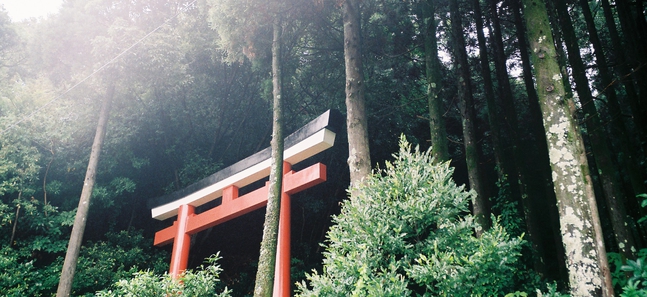
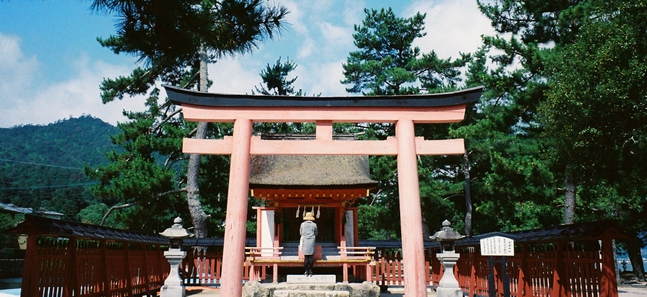
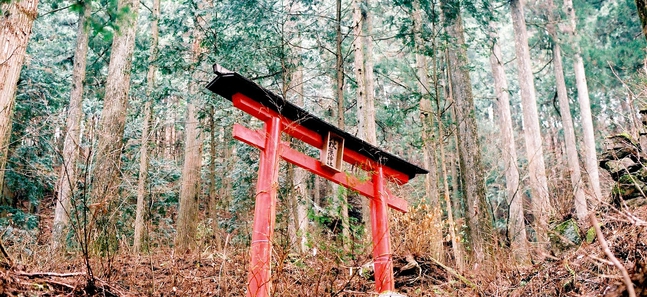

When you're planning a journey around Japan, the theme of your travels can take on many forms. You can hunt down hot springs, try out the beautiful hiking paths or just hop on a train for the sake of tasting all the ekiben meals found at train stations. For something slightly different, we've put together a list of Japan's top torii gates, which are traditionally found at the entrance of Shinto shrines to mark the boundary between the human and spiritual worlds. We've even bucked the red and wooden trend to bring you torii gates in all shapes, sizes and colours – and given them each a nickname update. Got some better names? Tell us on Twitter.
Motonosumi Inari Torii
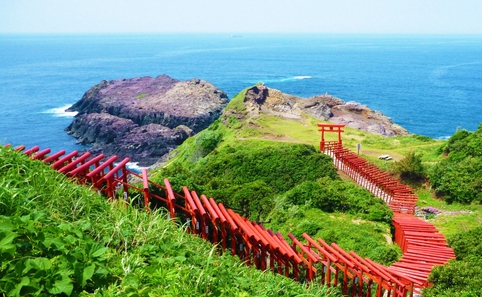
Image courtesy of Nagato City Tourism Board
What they call it: Motonosumi Inari Torii
What we call it: Mushu, the red dragon
Where to find it: Motonosumi Inari Shrine, Yamaguchi Prefecture
How to get there: Fly from Haneda Airport to Yamaguchi Ube Airport (more flight info here). The flight is about 1.5 hours, and it will take about another two hours to get the nearest station: the quickest way is to take a bus to Ube-Shinkawa Station and transfer three times to get to Nagato-Furuichi Station. From this station, it's ten minutes by taxi to the torii gate. You can also take the shinkansen from Tokyo to Yamaguchi or Shimonoseki (4.5 hours) and change to the San'in Main line from there.
Kyoto's Fushimi Inari Taisha might be famous for its 5,000 torii gates, but not even that can match up to this impressive stretch of 123 torii gates that overlook the Sea of Japan. Legend has it that the shrine was constructed after a local fisherman dreamt of a white fox instructing him to hold a religious ceremony in the area. Apparently this is one of the best shrines to pray for good luck, although it's also one of the most challenging in terms of trying to toss your money into the donation box.
Amanoyasu Gawara Torii
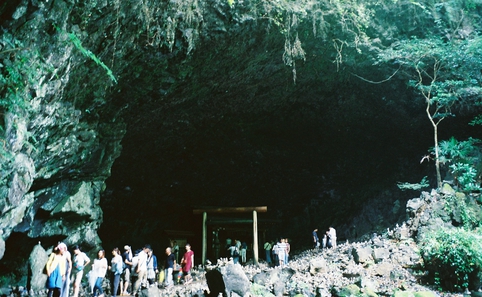
What they call it: Amanoyasu Gawara Torii
What we call it: Fred Flintstone
Where to find it: Amanoiwato Shrine, Miyazaki Prefecture
How to get there: Fly from Haneda Airport in Tokyo to Miyazaki Airport, then take the Miyazaki Airport Line to Miyazaki Station. Or, if you don't mind an approximately 10-hour journey, take the Tokaido-Sanyo Shinkansen from Tokyo to Kokura Station, then take the Nippo limited express train to Nobeoka Station. From Nobeoka Station, take the Miyako bus for Takachiho to the last stop, then transfer to a local bus from Takachiho Bus Center to Amanoiwato-Jinjamae.
This cheeky caveman is tucked away on the spiritual grounds of Amanoyasu Gawara, the cave where sun goddess Amaterasu is said to have hidden away. Legend has it that eight million gods gathered here to try and connvince Amaterasu to come out of hiding and bring back the sunlight. Stacking stones in the cave is said to bring good luck. It's also just a short bus ride away from Takachiho Gorge, one of the most spirital spots in Japan.
Oyunohara Torii

What they call it: Oyunohara Torii
What we call it: The BFG
Where to find it: Kumano Hongu Taisha, Wakayama Prefecture
How to get there: Fly from Haneda Airport in Tokyo to Nanki-Shirahama Airport, then take the Meiko bus to Hongu-taisha-mae bus stop. Or take the shinkansen from Tokyo Station or Shinagawa Station to Nagoya, change to the JR Kisei Main line to Shingu Station, then take a bus bound for Kumano Hongu.
Japan's largest torii, Oyunohara is 33.9m in height and 42m in width. It stands on a rice paddy next to the former site of Kumano Hongu Taisha (the shrine was moved to a nearby hill after a flood in 1889). You will find an interesting mix of Shintoism and Buddhism features in the area which illustrates the interchange and development of religious cultures in East Asia. While you're here, also check out the four Kumano Kodo pilgrimage routes, which stretch across the mountainous Kii Peninsula and are registered as a UNESCO World Heritage Site.
Ishizukuri-myojin Torii
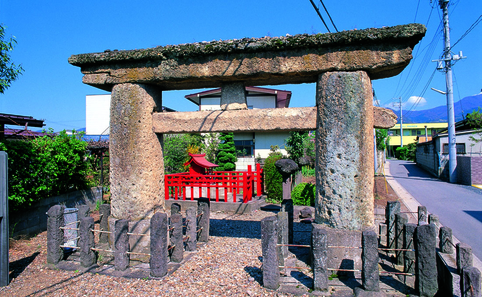
Photo courtesy of Yamagata City Tourism Office
What they call it: Ishizukuri-myojin Torii
What we call it: Rocky
Where to find it: Toriigaoka, Yamagata Prefecture
How to get there: Fly from Haneda Airport in Tokyo to Yamagata Airport. Or take the shinkansen from Tokyo to Yamagata Station. From the station, it's just seven minutes by bus.
Rocky is not very tall (3.5m) but his stocky stature hasn't stopped him from being designated a national Important Cultural Property. This torii is special for having Heian (794-1185) designs, being made of tuff (consolidated volcanic ash) and for being one of the oldest rock torii gates in Japan.
Meoto Iwa
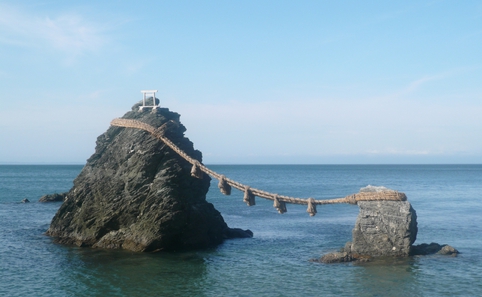
Photo courtesy of Futami Okitama Shrine
What they call it: Meoto-iwa
What we call it: The love doves
Where to find it: Futamiokitama Shrine, Ise, Mie Prefecture
How to get there: From Tokyo, take the shinkansen to Nagoya Station and change to the Mie rapid train to Futaminoura Station (or the Sangu line if you decide to go by local trains). It's 15 minutes' walk from Futaminoura Station.
Meoto Iwa, or the ‘Husband and Wife Rocks’, stand side by side like a married couple in Futami Bay in front of the Futami Okitama Shrine and represent marital union. Joined by a shimenawa rope, the rocks act as a torii gate and are dedicated to worshipping Amaterasu, the Goddess of the Sun, as well as the sacred rock called Okitama-shinseki, which sits about 650m away from the couple. See if you can spot the tiny symbolic torii gate that sits atop Izanagi, the large 'husband' rock. What kind of special power does this happy couple hold? Three guesses.
Kamiiso Torii
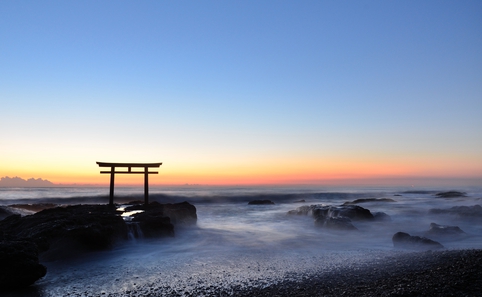
Zensyou/Pixta
What they call it: Kamiiso Torii
What we call it: The French lieutenant's woman
Where to find it: Oarai Isosaki Shrine, Ibaraki Prefecture
How to get there: Take the Express Hitachi or the Express Tokiwa train from Tokyo to Mito Station, then change to the Oarai Kashima line to Oarai Station. The shrine is 2.5km from Oarai Station so it's a nice walk to the coast, but those who want to save time can catch a taxi.
Gazing out to sea from atop a rock as if waiting for a long-lost lover to return, Kamiiso Torii is mysterious and beautiful. The gate serves as another famous gathering spot for Shinto gods. In winter, the sun rises directly over the torii, which is believed to link it with the main temple of Oarai Isosaki Shrine – and it sure makes for a pretty picture.
Kurokami Maibotsu Torii

Photo courtesy of Sakurajima Museum
What they call it: Kurokami Maibotsu Torii
What we call it: Corpse Bride
Where to find it: Haragosha Shrine, Sakurajima, Kagoshima Prefecture
How to get there: Fly from Narita Airport or Haneda Airport to Kagoshima Airport, then take the airport bus to Kagoshima-Chuo Station. Transfer to the shuttle bus that's headed for Sakurajima Ferry Terminal. Sakurajima is 15 minutes by ferry. You can also take the Sanyo Shinkansen from Tokyo to Kagoshima-Chuo Station, with one transfer at Shin-Osaka Station or Hiroshima Station.
This three metre-high stone torii has been buried in volcanic lava and ash since the eruption of Sakurajima in 1914, leaving just its head peeking out. It was actually completely covered but builders discovered it while doing excavation work in the process of building a school in the area. The village mayor took the decision to leave it partially buried in remembrance of the devastating eruption.
Sankaku Ishi Torii
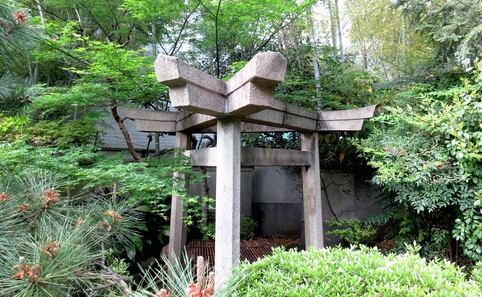
What they call it: Sankaku Ishi Torii
What we call it: The Bermuda Triangle
Where to find it: Mimeguri Shrine, Tokyo
How to get there: 15 minutes' walk from Asakusa Station (Ginza, Tobu Skytree, Toei Asakusa lines) or Honjo-Azumabashi Station (Toei Asakusa line)
If you're fed up with the crowd at tourist-heavy Sensoji Temple, head to Mukojima just on the other side of Sumida River for the more modest, tranquil Mimeguri Shrine. The torii gate's unusual three-legged form is designed to create a centre point that represents the universe. It's one of only three documented torii gates in Japan with this triangular shape.
Heiwa-no-Torii (Torii of Peace)

What they call it: Heiwa-no-Torii (Torii of Peace)
What we call it: Life of Pi
Where to find it: Hakone Shrine, Kanagawa Prefecture
How to get there: From Shinjuku Station, take the Odakyu train to Hakone-Yumoto Station, then take the Hakone Tozan bus to Moto-Hakone boat pier and walk five minutes to the shrine. Or take the Odakyu Hakone Highway Bus from Shinjuku Station to the Yama Hotel bus stop in Hakone and walk a few minutes to the shrine. Buses also leave from Yumoto Station and Atami Station in Tokyo.
Standing solemnly on Lake Ashi and known as the ‘peace torii’, Heiwa-no-Torii is flanked by 800-year-old cedar trees and on clear days you can glimpse Mt Fuji in the distance. A beautiful foresty stretch leads to the shrine and torii gate, which has a small landing attached so that you can walk directly beneath it. For more details about visiting Hakone, click here.
Unknown
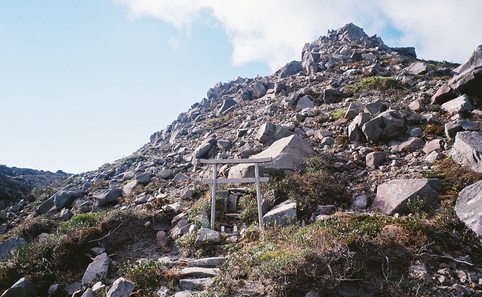
What they call it: Unknown
What we call it: No-name brand
Where to find it: Kozushima island, Tokyo
How to get there: Take a 12-hour overnight ferry (or a more expensive 2.5-hour jet ferry) from Tokyo's Takeshiba Ferry Terminal to Kozushima island, then hike two hours up Mt Tenjo (the entire hike takes four to five hours).
Climb Mt Tenjo and you'll find this small anonymous torii gate on the way to Fudouike, a pond just near the mountain's peak. Shorter than the average Japanese person and minding its own business in the middle of the wild, this torii gate flies under the radar with hardly any information about it available online.
Soryu 'Double Dragon' Torii

What they call it: Soryu Torii
What we call it: Crouching Dragon Hidden Dragon
Where to find it: Mabashi Inari Shrine, Tokyo
How to get there: Twelve minutes' walk from Koenji Station.
These two dragons have curved and coiled around the torii of Mabashi Inari Shrine since 1932. Can you tell which one is climbing up and which one is slithering downwards? This torii is considered the most elegant of the three gates in Tokyo that bear the mythical beast. If you do visit, check out our Koenji area guide before you go.
Momo no Torii

Photo courtesy of Inuyama Tourist Information
What they call it: Momo no Torii
What we call it: Pink horseshoe
Where to find it: Momotaro Shrine, Inuyama City, Aichi Prefecture
How to get there: From Tokyo, take the shinkansen to Nagoya Station and change to the Meitetsu Inuyama line to Inuyama-Yuen Station. From there, it's 10 minutes by taxi or a four-kilometre walk.
With its pale pink colour and unconventional shape, this is one of the most charming toriis around. The shrine is dedicated to Japanese folklore hero Momotaro ('Peach Boy' because he was born from a peach), who was allegedly 'born' in the area, and is a short walk from Momotaro Park. Well, that explains the colour. The shrine is a famous protector of children and the best time to visit is on Children’s Day (May 5) to pray for happiness.
Nishiki Tenmangu Torii
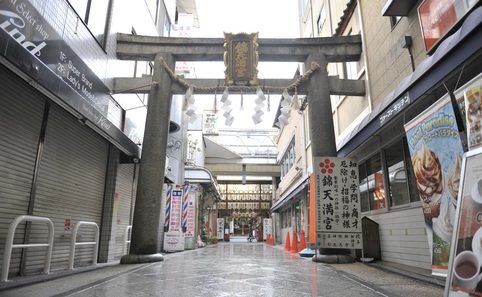
Photo courtesy of Nishiki Tenmangu
What they call it: Nishiki Tenmangu Torii
What we call it: Super-Man
Where to find it: Nishiki Tenmangu, Kyoto
How to get there: Take the shinkansen or night bus from Tokyo to Kyoto, then transfer to local metro lines to get to Shijo Station, then transfer to the Hankyu Kyoto Main line to get to Kawaramachi Station. The shrine is a four-minute walk from Kawaramachi Station inside the shopping arcade.
Talk about an epic urban planning fail… but we guess no-one could really have predicted the way Kyoto's Nishiki area has developed. The buildings got taller and taller but, since you can't exactly demolish a sacred torii, the gate is now wedged between two walls as if holding them apart with all its might. After viewing, stop by 'Kyoto’s kitchen', the Nishiki Market.
The Second Torii of Sanno Shrine

Photo courtesy of Nagasaki City Tourism Office
What they call it: The Second Torii of Sanno Shrine
What we call it: RoboCop
Where to find it: Sanno Shrine, Nagasaki Prefecture
How to get there: From Tokyo, fly to Nagasaki Airport, and take the JR Nagasaki Main line to Urakami Station. From there, it's 10 minutes' walk.
Sanno Shrine actually had two toriis once upon a time but now there's only half of one left. Located just 800m from hypocentre of the 1945 atomic bomb, the first gate was completely destroyed in the explosion, while the second torii lost a leg in the blast and now stands proudly as a memorial of the devastating attack. You can still see the rubble of the destroyed torii lined up neatly on the side of the pavement and the lush green camphor trees that were scorched but have survived.
Miyajima O-Torii
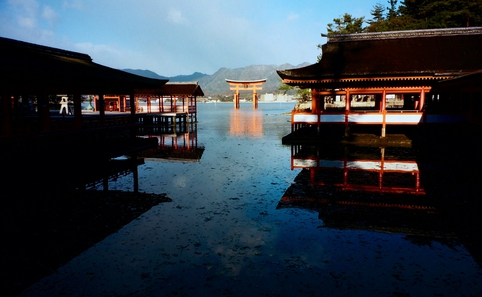
What they call it: Miyajima O-Torii (The Big Torii of Miyajima)
What we call it: Nessie
Where to find it: Itsukushima Shrine, Hiroshima Prefecture
How to get there: From Tokyo, fly to Hiroshima Airport or take the shinkansen to Hiroshima Station. Take the Sanyo Main line to Miyajima-Guchi Station and transfer to JR West Miyajima ferry or Matsudai ferry which will get you to Miyajima island in about 10 minutes.
Registered as a World Heritage Site in 1996, this towering torii is the tallest wooden gate in Japan and, unlike Nessie, you can always see it. But you can't always walk up to it – when the tide is high, it is completely surrounded by the waters of the Seto Inland Sea. If you take a closer look at its base, you'll see that it's designed with special materials to withstand erosion from the water. Check the tide table here. The original gate was damaged by fire and the one you see now was rebuilt in 1873. Read more about it here.
How to wish upon a torii, literally…

Where to find it: Koyasu Shrine in Ise Grand Shrine, Mie Prefecture
How to get there: From Tokyo, take the shinkansen to Nagoya Station and change to the Express Mie train to Iseshi Station. From here, it's 15 minutes by taxi. It's relatively close to the Meoto Iwa rocks (also in Mie Prefecture).
If you're preparing to have a baby, head to Ise Grand Shrine where you'll find the modest Koyasu Shrine that's dedicated to the spirits that have powers to grant you a child or a smooth labour. It works in a similar fashion to the traditional ema, the small wooden plaques on which you write your wish. In the case of the torii, you write you and your partner’s name, and the date. Be prepared for the masses of couples you'll be 'praying' with.
Tweets
- About Us |
- Work for Time Out |
- Send us info |
- Advertising |
- Mobile edition |
- Terms & Conditions |
- Privacy policy |
- Contact Us
Copyright © 2014 Time Out Tokyo











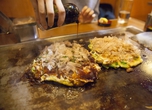


Add your comment